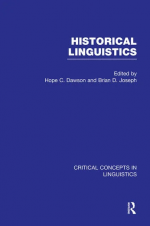Tab Article
Historical linguistics is concerned with the way languages change over time, looking both at the distant past and at the present day, and taking as its point of departure the truism that the only constant in language is that it is always changing. This new title from Routledge’s Major Works series, Critical Concepts in Linguistics, assembles in six volumes foundational and canonical pieces, together with the very best cutting-edge research, from this rich and flourishing field.
With a full index, together with a comprehensive introduction, newly written by the editors, which places the collected material in its intellectual context, Historical Linguistics is an essential work of reference. The collection will be particularly useful as an essential database allowing scattered and often fugitive material to be easily located. It will also be welcomed as a crucial tool permitting rapid access to less familiar - and sometimes overlooked - texts. It is a vital one-stop research and pedagogic resource.


